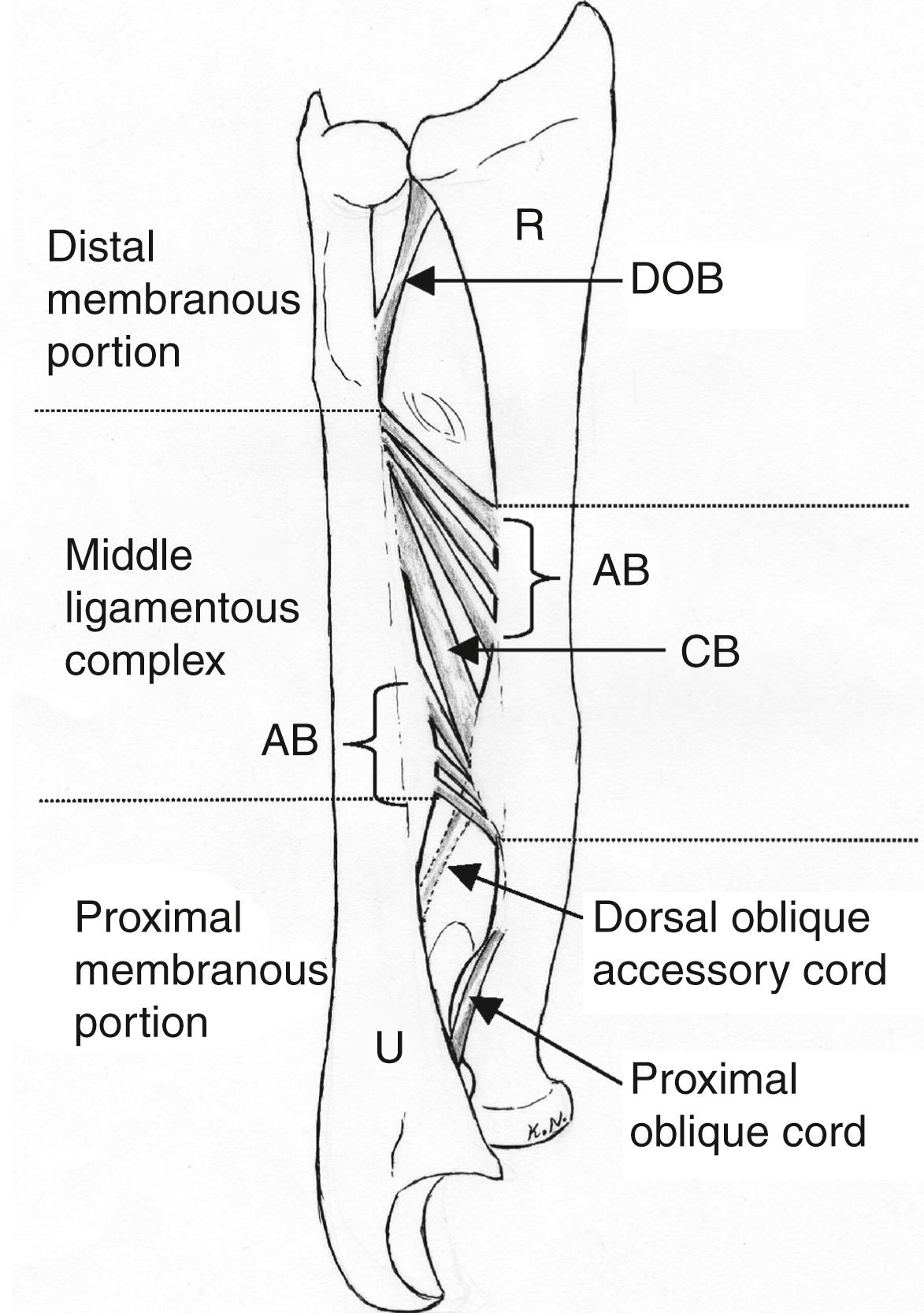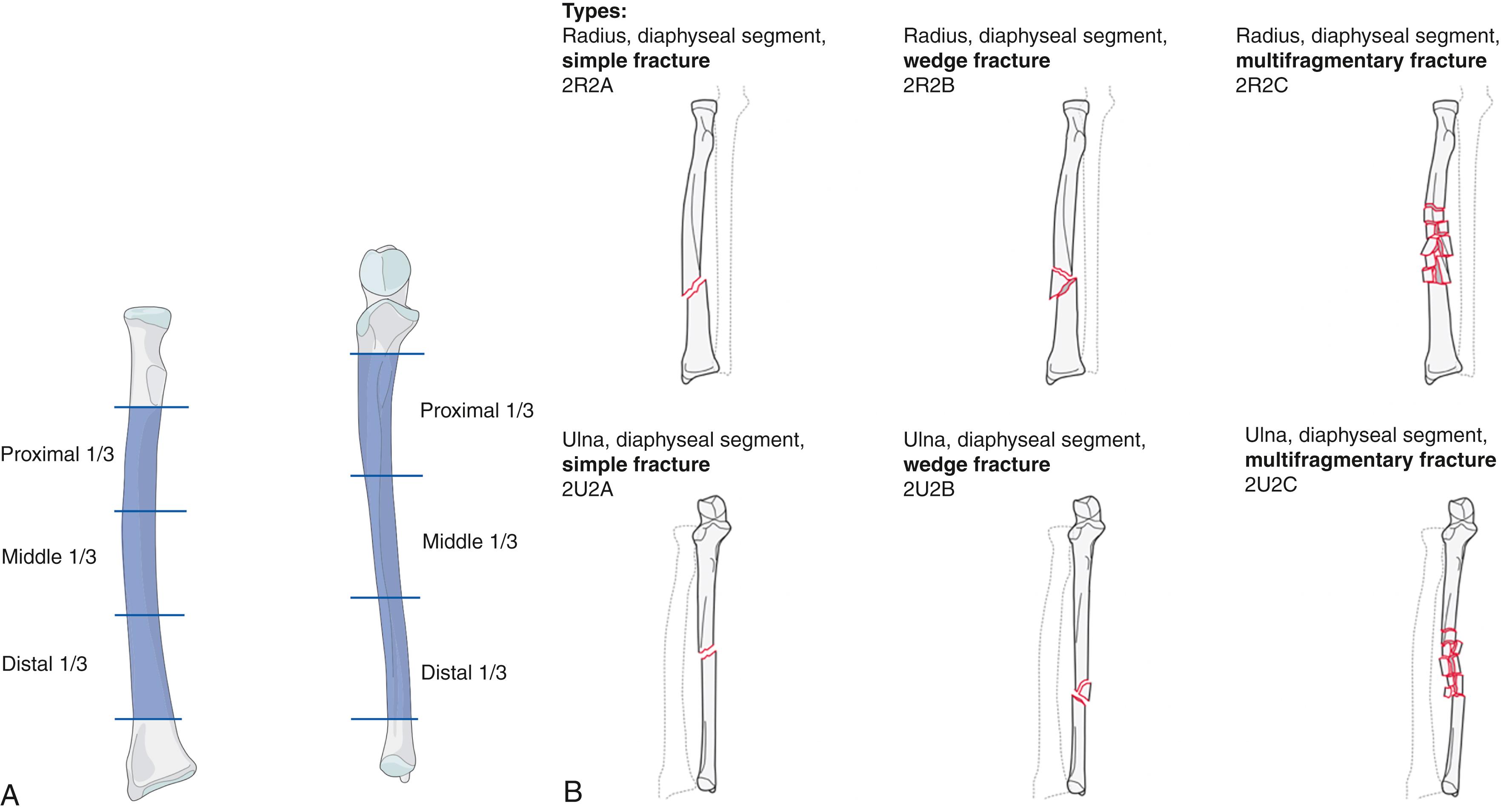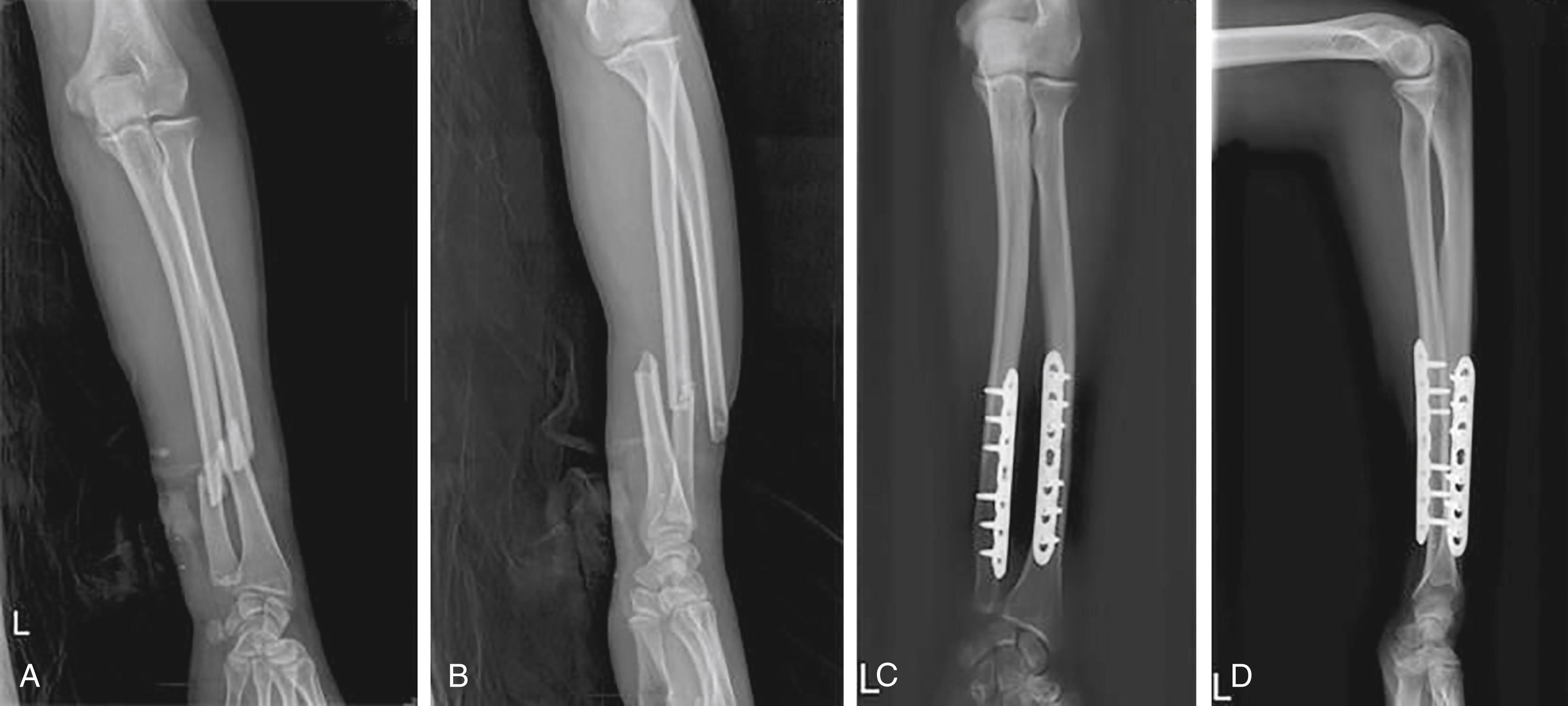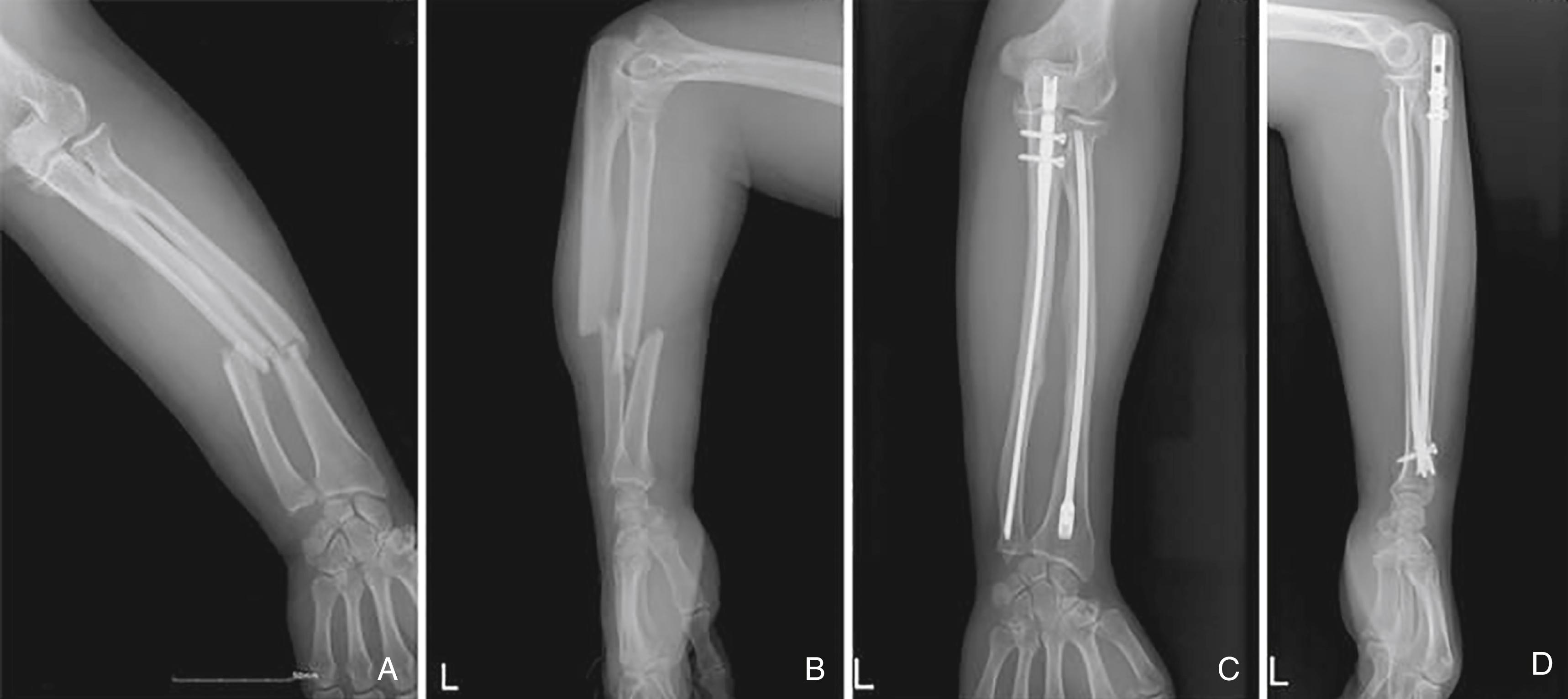Physical Address
304 North Cardinal St.
Dorchester Center, MA 02124
The diaphyseal forearm functions to provide a stable platform upon which the hand can be positioned in space, as well as to facilitate forearm rotation. The ulna functions as the dominant load-bearing structure, with the radius rotating about it in pronation and supination. The soft tissue envelope about the diaphysis of the forearm is composed of the superficial and deep volar compartments, the extensor compartment, and the mobile wad. Transiting neurovascular structures are at risk both at the time of injury and during the surgical approach. Proximally, the median nerve enters the mid-forearm between the heads of pronator teres and runs between flexor digitorum superficialis (FDS) and flexor digitorum profundus (FDP). The anterior interosseous nerve branches from the proper median nerve at the proximal aspect of FDS and courses between the two heads of FDS. More distally, the palmar cutaneous nerve comes off the median nerve 8.5 cm from the volar wrist crease, putting it at risk during the surgical approach for distal-third fractures. The ulnar nerve exits the cubital tunnel between the heads of flexor carpi ulnaris (FCU) and travels between FDP and FCU as it traverses the mid-forearm. The radial nerve divides in the proximal forearm into the posterior interosseous nerve (PIN) and the superficial sensory branch. The course of the PIN is particularly important in considering the treatment of radial shaft fractures, as it runs in close proximity to the proximal third of the radial shaft and pierces through the supinator, placing it at risk from traumatic injury as well as from iatrogenic injury during a surgical exposure. The superficial radial nerve is also at risk as it travels deep to brachioradialis throughout the entirety of the mid-forearm before exiting dorsally 8 cm proximal to the radial styloid. The nerve travels with the radial artery beneath brachioradialis, with the radial artery coming off the brachial artery as it passes beneath the bicipital aponeurosis.
At the diaphysis, the structures of the interosseous membrane (IOM) are the primary stabilizers of the radius in axial load and pronosupination. The IOM also contributes to the stability of the proximal radioulnar joint (PRUJ) as well as resists proximal migration of the ulna relative to the radius. The distal radioulnar joint (DRUJ) and the PRUJ play important roles in stability proximally and distally and are often injured in the setting of shaft fractures. Radiographic fracture displacement is itself a marker of potential significant disruption of the IOM, and subsequent instability. The IOM is divided into distal and proximal membranous portions, with a middle ligamentous portion providing stability in the mid-diaphysis ( Fig. 58.1 ). The complex mechanism of forearm rotation is predicated upon the anatomic relationship between the bowed radius and the relatively straight ulna. The bow of the radius is directed radially and dorsally and establishes a spatial relationship between the radius, ulna, and IOM. Disruption of this relationship leads to functional deficit, primarily in pronosupination, often necessitating surgical intervention to restore the native anatomy. In addition to establishing length, alignment, and rotation, recreating the radial bow is essential in the treatment of forearm fractures.

Fractures of the diaphyseal radius and ulna are typically the result of a high-energy trauma or fall. Both bone forearm fractures often result from an axial load through the hand and wrist, or in the case of isolated ulnar shaft fractures, a direct blow to the medial forearm. , It is important in the initial evaluation of these injuries to rule out associated injuries at the wrist and elbow. Radial and ulnar shaft fractures as discussed in this chapter are distinct from related injuries such as Galeazzi and Monteggia fractures and are isolated from the wrist joint distally and the elbow joint proximally.
There is no universally accepted classification method for diaphyseal forearm fractures. For the purposes of surgical intervention, the radial and ulnar shafts are divided into thirds ( Fig. 58.2A ). The proximal third is demarcated by the radial tuberosity and the beginning of the radial bow, with the middle third encompassing the bow to the point where the diaphysis begins to straighten distally, and the distal third ending at the metaphyseal flare. The AO classification is most useful in aiding decision-making on direct versus indirect reduction, approach, and implant choice ( Fig. 58.2B ).

Isolated ulnar shaft fractures are classified as either “stable” or “unstable.” Stable fractures are considered those in the mid-third or distal third of the diaphysis with <50% displacement or 10 degrees of angulation. Fractures with >50% displacement, >10 degrees of angulation, and those involving the proximal third are generally more unstable. Those associated with instability at the PRUJ and DRUJ are inherently unstable and represent a distinct entity from isolated shaft fractures.
Given the importance of anatomic reduction of radial shaft in maintaining range of motion in pronation and supination, nearly all radial shaft fractures in adults are treated with operative intervention. Only in the setting of limited baseline function or specific patient goals of care would nonoperative management be considered. Isolated ulnar shaft fractures, however, are often amenable to nonoperative measures and there remains no absolute indication for surgical intervention. The primary distinction in the management of isolated ulnar shaft fractures is dictated by whether the fracture is deemed stable or unstable, as discussed above. Functional bracing provides stability while allowing for range of motion at the elbow and is preferred for nonoperative management over long arm cast immobilization. Completely nondisplaced fractures of the radius may also be treated with a period of cast immobilization, but these are rare.
Plate fixation is the mainstay of surgical treatment for fractures of the radial and ulnar diaphysis ( Fig. 58.3 ). Open reduction and fixation allows for anatomic reduction of the radial bow, provides the surgeon with the option to bone graft primarily should there be extensive bone loss, and has a proven track record in the literature with a high rate of union. Plate fixation can provide a rigid construct, theoretically allowing for primary bone healing and minimal callus formation. In the setting of the complex anatomic relationship of the radius and ulna with respect to forearm rotation, this is a potential benefit over a relative stability construct generating robust callus in close proximity to the IOM. In the setting of extensive comminution, bridge plate constructs are optimal to help maintain length and rotation. Postoperative immobilization can be minimal, and patients are able to begin early range of motion at the wrist and elbow. However, open reduction internal fixation (ORIF) of the forearm comes with well-documented challenges related to management of soft tissues, as well as the neurovascular structures in close proximity to the radial and ulnar diaphysis. Plating of the radius often necessitates attempting to fit a straight plate at the apex of the radial bow, which can lead to malreduction if not appropriately contoured or positioned. The recommended approaches, potential pitfalls, and outcomes related to plate fixation are detailed in the remainder of this chapter.

Intramedullary (IM) fixation is a frequently used technique for stabilization of long bones in both upper and lower extremities ( Fig. 58.4 ). However, while the IM constructs for the forearm have been frequently employed in the pediatric population, nailing of diaphyseal radius and ulna fractures in adults remains relatively rare in comparison. The first IM devices used for forearm fixation were a series of unlocked implants, including K-wires and Rush rods. , Historically, IM implants were problematic for a number of reasons. While the length, alignment, and rotation of the relatively straight ulna seemed amenable to IM fixation, it was difficult to restore the natural anatomic bow of the radius. Unlocked nailing constructs were prone to rotational deformity. Biomechanical studies of unlocked nails demonstrate less stiffness to torsion, with increased distraction at the fracture site compared to plate constructs. With the advent of interlocked and precontoured implants, modern IM devices are potential options for the treatment of isolated shaft and both bone forearm fractures. IM implants offer the benefit of respecting a soft tissue envelope in the acute setting, often are associated with shorter operative times and lead to less periosteal stripping. Furthermore, they can easily span the entire length of the radius or ulna, offering stabilization to the entirety of the bone in the setting of a pathologic fracture. Contraindications to nailing include active osseous infection, canal diameter too small to accommodate implants (generally 3 mm), and intra-articular fractures requiring reduction and subsequent fixation. Despite design advances, IM fixation still has limitations—it requires longer postoperative immobilization compared to ORIF, has lower torsional stiffness compared to plate constructs, is suboptimal for maintaining length and rotation in the setting of extensive comminution, and can be associated with distraction at fracture site when compared to compression plating.

Become a Clinical Tree membership for Full access and enjoy Unlimited articles
If you are a member. Log in here